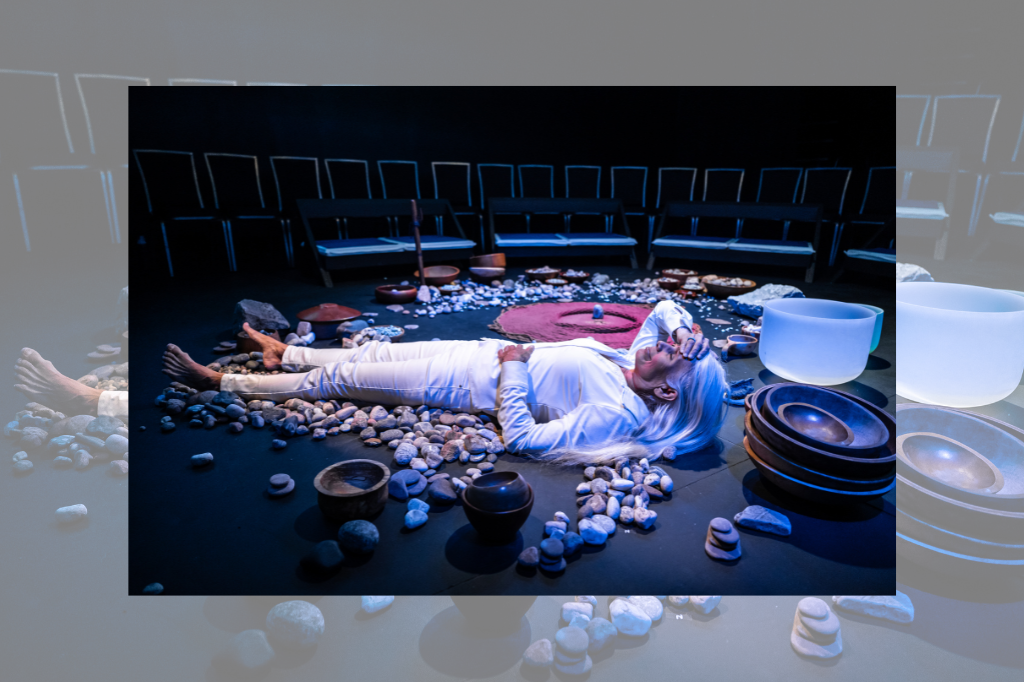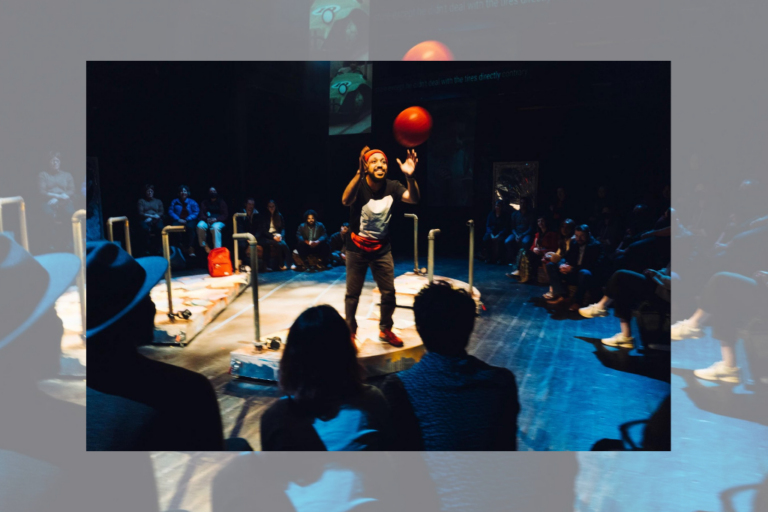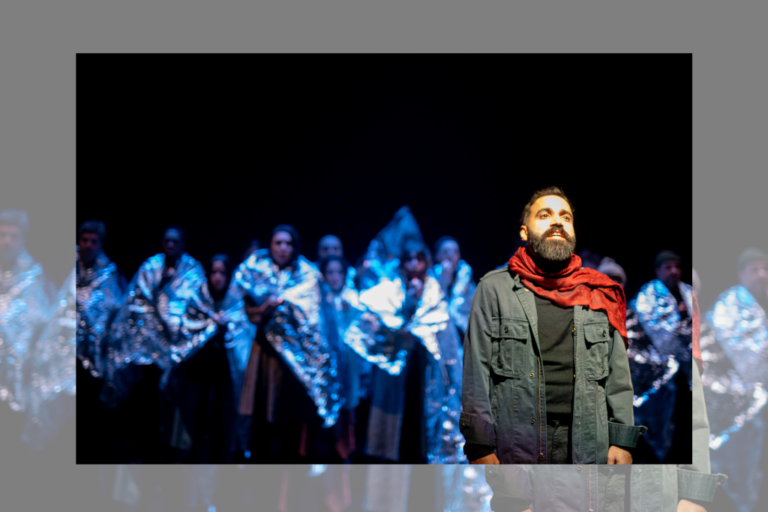REVIEW: In Prophecy Fog, Jani Lauzon ceremonially reclaims the Giant Rock
Content warning: this review mentions themes of racism and antisemitism.
The moment you step into Coal Mine Theatre, you become one with Jani Lauzon’s mesmerizing presence. You are an inch further from the cold asphalt streets of Toronto and an inch closer — literally closer, because you’re encouraged to take your shoes off upon entering the space — to a ground full of stones.
There’s none of the usual, hushed chatter of the audience before the performance because no one can take their eyes away from the centre, where Lauzon stands. Everyone present for opening night on November 15 simply watched in a trance, as her every gentle arm movements and head tilts commanded our attention as we awaited the ceremonial performance she created and Franco Boni directed: Prophecy Fog.
The only thing that separates Lauzon from the shoeless audience that sits in a circle around her is her vast collection of stones. Soon after Lauzon begins her performance, however, I came to realize that the stones are her co-performers, or “scene partners,” as Lauzon described in promotional materials for the show. Her physical and emotional engagement with her scene partners guides her 75-minute-long performance. She rubs and hugs them, sits and steps on them, and — when she recalls a specific memory of the past — places one gently on her forehead.
With Melissa Joakim’s environmental design and Julia Aplin’s movement direction, Lauzon leads the audience into the journey she took with her daughter, actor Tara Sky, to visit the Giant Rock in California’s Mojave Desert. The stones on the ground enhance the immersiveness of the raconteur’s storytelling, as she carefully steps through them and the hovering, circular screen displays videos of peaceful skies: we quite literally trace her trip to the sacred rock through her eyes.
The Métis artist consistently emphasizes how Indigenous nations have deemed the rock sacred for many years. This is why our metaphysical journey to the rock — through Lauzon’s monologue — garnered much anticipation from me. The road to the sacred space is beautiful, even sublime, and Lauzon’s excitement from the time is palpable. When we reach the colossal boulder, however, Lauzon drops to the ground in the middle of her stage. She lies there, as unmoving as her stones, while the audience’s eyes gaze up to the footage of the rock: a scene of blatant, spiteful vandalism.
The sacred rock is covered with graffiti of lewd graphics, a swastika, and scarring words of white supremacy and homophobia. The rock is also surrounded with scattered trash and broken empty bottles. Lauzon allows the audience a long, silent period to take in the scene and ponder the question around which her performance is centred: can a site be sacred even when it’s been desecrated?
When staring into the visuals of the horridly vandalized Giant Rock, it is not difficult to become exasperated at the sheer evil of people’s territorial desire for everything Indigenous people possess and honour. The selfish greed of those people created a visceral reaction out of me and, if that’s what Lauzon intended through her visual storytelling, she succeeded. But the focal point of Lauzon’s performance isn’t to simply make the audience be exasperated at malice.
Rather, I saw it as an attempt to pass the baton of oral knowledge-sharing through the stories that she retains from her mother and then transmits to her daughter, to us, and to her stones. The vandalism, greed, and atrocity that stems back to the colonial establishment of Canada on Indigenous land is a fog to her. While cruelty may blur the prophecies and orature from her mother and ancestors, Lauzon reminds her daughter, and us, not to get lost in it.
And when Lauzon fears getting lost, she returns to her stones.
One of the stones she rubs and brings to her forehead during the performance allows her to listen to her mother’s voice and hear what her mother said to her many years ago: “we come from the stars, we are star people.” To Lauzon and her mother, we are all stars, stones, and the earth. This idea dropped me into a meditative reassurance. We are as significant as a star and a stone. A star and a stone are as significant as us. With this logic, Lauzon breathes life into the Giant Rock and reclaims its existence and sacredness.
As a non-Indigenous member of Prophecy Fog’s audience, I am cautious of unfolding my interpretation onto Lauzon’s spiritual connection with the Giant Rock and the site. But I carefully assume that Lauzon’s lessons from her mother that she relays to us can reveal the answer to her performance’s central question on whether a desecrated site can retain sacredness. And that is something she must relay to you at Coal Mine Theatre — not me. Hear it from her and her stones.
Prophecy Fog runs at Coal Mine Theatre until December 10. Tickets are available here.
Intermission reviews are independent and unrelated to Intermission’s partnered content. Learn more about Intermission’s partnership model here.












Comments